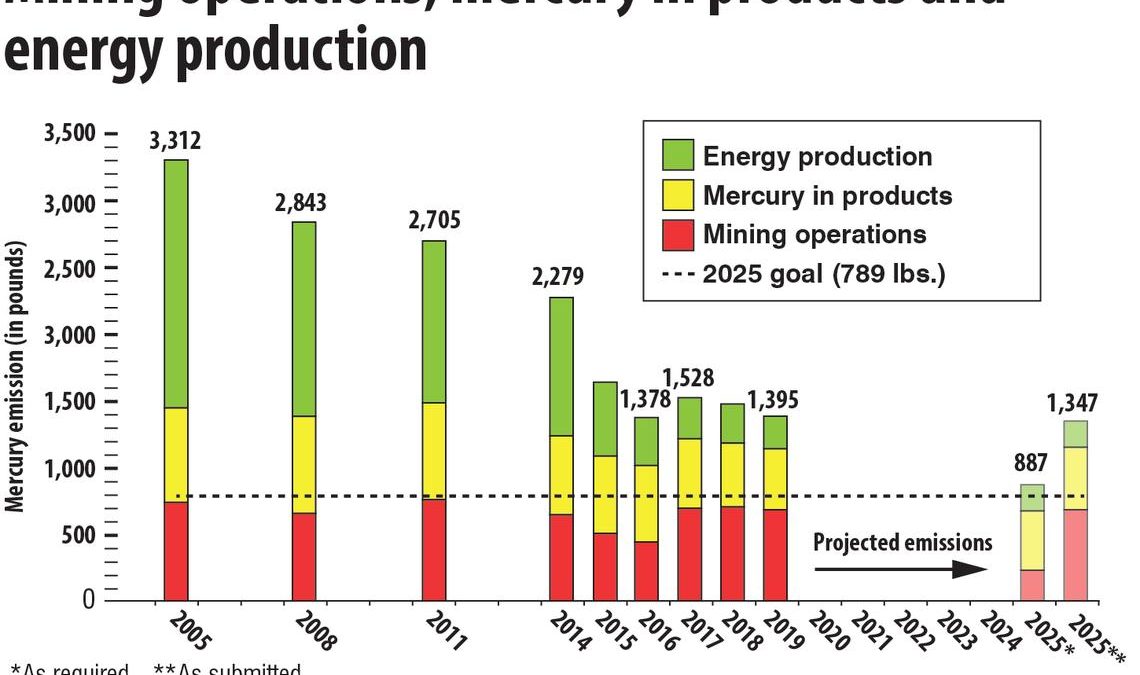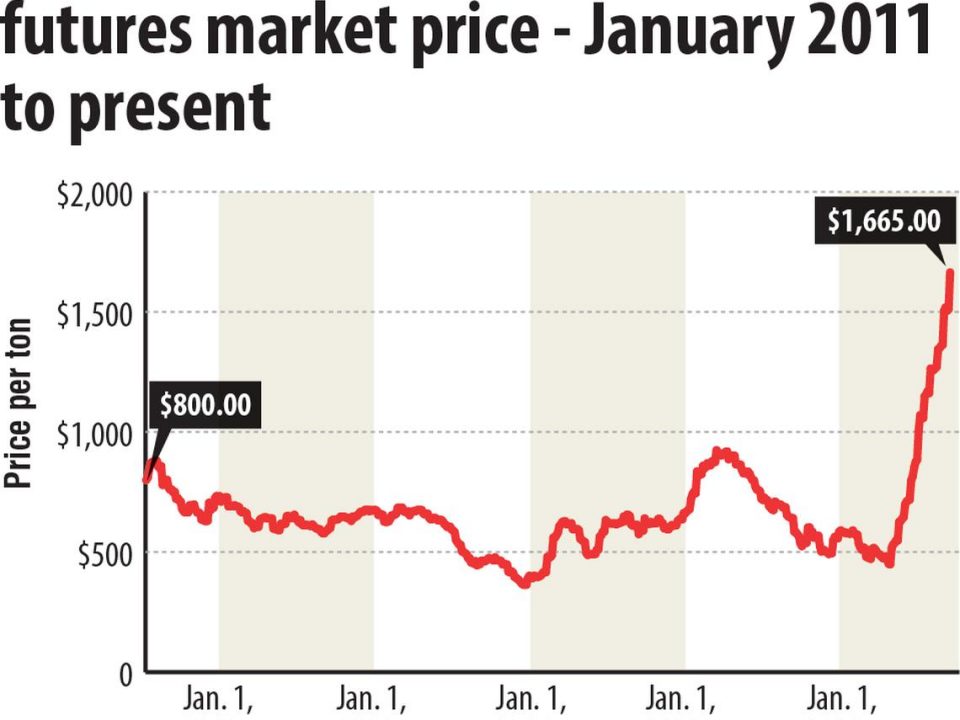
Thailand aims at pandemic risks by fighting wildlife trade
May 28, 2021
California giving $116 million to people who get virus shots
May 28, 2021Minnesota has made strides in curbing mercury emissions, mainly through the retirement and retrofitting of coal-burning power plants, but to come close to reaching its goal of 789 pounds of mercury emissions each year across all sources by 2025 — a 93% reduction from 1990 levels of nearly 11,300 pounds of mercury per year — the iron ore mining and pellet industry is required by the state to reduce its mercury emissions by 72% by 2025: from 806 pounds per year (the maximums from 2008 and 2010) to 226 pounds per year.
However, according to plans filed in 2018 by the state’s taconite plants, only two operating plants have agreed to reduce mercury emissions, resulting in an expected industrywide reduction of just 15%, or down to 685 pounds per year, by 2025.
Mining operations, mercury in products and energy production
“It’s disappointing and it’s frustrating that we’re not on track to meet those goals,” Craig McDonnell, the MPCA’s assistant commissioner for air and climate policy, said in an interview. “Nobody enters into negotiations thinking you’re going to set a goal that you can’t meet. So in 2009, my presumption would be that everybody thought we could meet this — we’re not on pace.”
Combined with the expected emissions from power plants and product use and disposal, the failure of the taconite industry to meet its 2025 goal would mean 1,347 pounds per year of mercury emissions — well above its statewide goal of 789 pounds per year across all industries.
“Despite significant reductions from some sectors, the MPCA projects that the state will not meet the plan’s 2025 statewide reduction goal. Meeting that goal will require significant reduction of mercury emissions from the taconite mining sector and further reductions from mercury use in various products,” the MPCA warned in its report on air emissions to the Legislature earlier this year.
The level of mercury in taconite generally increases from east to west along the Mesabi Range and is released into the atmosphere through stack emissions as the pellets are fired, or hardened, in the pelletization process, according to a 2003 report from the Department of Natural Resources.
Freshly made taconite pellets emerge from the 2,350-degree Furnace No. 5 at Northshore Mining Co. (File / News Tribune)
Mercury, a powerful neurotoxin, is then brought down into water bodies by rain and snow and into fish. While the MPCA estimates about 90% of the mercury in Minnesota comes from outside the state, McDonnell said the state and others all need to work to reduce mercury in the atmosphere.
“Minnesota has folks who really are practicing the subsistence diet and eating a lot of fish — a healthy, lean source of protein, typically. And that’s a positive thing,” McDonnell said. “However, it’s not a positive thing when a fish tissue is impaired with mercury … it’s a neurological toxin and it has devastating effects on particularly young kids.”
The Minnesota Department of Health in 2011 found 10% of Minnesota infants born in the Lake Superior basin had mercury levels above the U.S. Environmental Protection Agency’s reference dose for methylmercury, the type of mercury in fish.
In plans filed in 2018 to the MPCA, the companies said reaching 72% reductions at most plants was too expensive or not compatible with existing processes and technology.
Of the six operating plants, only the two with the least amount of mercury emissions proposed any additional reduction: Northshore Mining Company in Babbitt and Silver Bay, and Minorca Mine in Virginia.
Cliffs’ Northshore Mining, which emits the least amount of mercury, was the only plant that said a 72% reduction in mercury was possible. It could reach that by shutting down its coal-fired power plant on site and changing work practices on its indurating furnace, resulting in a drop from 41 to 12 pounds of mercury per year.
Cleveland-Cliffs’ Northshore Mining in Silver Bay. (Clint Austin / 2020 file / News Tribune)
Minorca Mine, now owned by Cleveland-Cliffs, in 2018, then under ArcelorMittal, said it would reduce mercury emissions by 22% — from 67 to 52 pounds per year — by using “the existing wet scrubber controls with solids removal to prevent the reintroduction of mercury into the induration process. Minorca determined that the 72% mercury emissions reduction for the indurating furnace was not technically achievable or without unacceptable environmental impacts by any of the potentially available mercury emissions reduction technologies,” the company said in its plan.
The other four plants — U.S. Steel’s Minntac in Mountain Iron and Keetac in Keewatin and Cliffs’ Hibbing Taconite in Hibbing and United Taconite in Eveleth and Forbes — said reaching 72% reduction in mercury emissions was cost-prohibitive or not technically achievable.
Technologies were often well above the $7,100 per pound of mercury reduction that the taconite industry considers as an acceptable cost. Some technologies would run into the hundreds of thousands of dollars per pound, the companies said.
But McDonnell of the MPCA said the agency is “bullish” on activated carbon injection, which can control mercury emissions coming out of the stack.
“We want to understand how we can work with companies to install control technology like that,” McDonnell said.
Cliffs did not respond to the News Tribune’s request for comment.
In an emailed statement, U.S. Steel spokesperson Amanda Malkowski said the company is in compliance with the mercury rule and noted the 2018 plans are still under review by the MPCA.
![]()
Mercury emissions at Minnesota taconite plants largely unchanged
“U.S. Steel continues its commitment to environmental protection, as shown by the ongoing mercury air emission reductions that have taken place at Keetac and Minntac for over 15 years,” Malkowski said.
Two plants that are not operating — Mesabi Metallics and Mesabi Nugget — said they would reduce emissions by 72% and 50%, respectively. However, Mesabi Metallics in Nashwauk is half-built and just lost its leases while the Mesabi Nugget iron nugget plant near Aurora, which opened in 2009, has been indefinitely idled since 2015.
McDonnell said the MPCA still believes 72% mercury emission reductions at each plant by 2025 is achievable and said the agency wants to work with companies to make it happen.
He would not specify what regulatory actions the MPCA could take against the companies to ensure they meet the 2025 goals but acknowledged the agency understands both the importance of the taconite industry to the state and the seriousness of mercury pollution.
“We’re in that cross — that tough spot,” McDonnell said.
But the agency is urging federal regulators to step in.
In September, the MPCA petitioned the EPA to set mercury standard on the taconite industry, something the federal agency has avoided for more than 30 years despite orders from U.S. Congress and a federal appeals court.
Through that, McDonnell said the EPA could require taconite plants to use a standard mercury-reduction technology across the industry.
“(Taconite plants) are the biggest driver right now for our (mercury) air emissions in the state. … That’s why it’s critical to continue to work with EPA to push on this,” McDonnell said.
Mercury, a potent neurotoxin that can harm human health even in small amounts, is found naturally in the Earth’s crust. While it is released into the environment from volcanic activity and weathering of rocks, its largest source is human activity, including burning coal and processing taconite iron ore, among other industries.
Mercury that falls to Earth can come from local and regional sources, but 90% of mercury in Minnesota originates from outside the state. That mercury can become toxic — called methylation — as it moves through the environment, falling back to Earth in the rain and snow and into water bodies. It can build up in small creatures, fish and animals that eat fish, including loons, eagles and people.
For fetuses, infants and children, the U.S. Environmental Protection Agency says the primary health effect of methylmercury is impaired neurological development. Methylmercury exposure in the womb, which can result from a mother’s consumption of fish and shellfish that contain methylmercury, can adversely affect a baby’s growing brain and nervous system. Impacts on cognitive thinking, memory, attention, language, and fine motor and visual/spatial skills have been seen in children exposed to methylmercury in the womb. Recent studies have shown that the developing nervous system of the fetus may be more vulnerable to methylmercury than is the adult nervous system.






